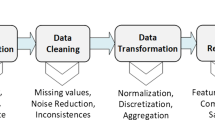Abstract
Communication networks and systems are continuously threatened by a great variety of cybersecurity attacks coming from new malware that targets old and new systems’ vulnerabilities. In this sense, Intrusion Detection Systems (IDSs) and, specifically, Network IDSs (NIDSs) are used to count on robust methods and techniques to detect and classify security attacks. One of the important parts in the assessment of NIDSs, is the Feature Engineering (FE) process, where raw datasets are transformed onto derived ones where both, features and observations are smartly transformed. In this work, the ff4ml framework, which includes the Feature as a Counter (FaaC) FE approach, is used to transform raw features into new ones that are counters of the originals. The FaaC approach aggregates raw observations by time intervals, thus limiting its use to network datasets containing timestamps. This work proposes a batch-based aggregation technique that allows applying FaaC in timestamp-less datasets and analyzes its impact on the performance of Machine Learning (ML)-based NIDSs in comparison to timestamp-based aggregation approaches.
Access this chapter
Tax calculation will be finalised at checkout
Purchases are for personal use only
Similar content being viewed by others
References
Ali, R., Ali, A., Iqbal, F., Khattak, A.M., Aleem, S.: A systematic review of artificial intelligence and machine learning techniques for cyber security. In: Tian, Y., Ma, T., Khan, M.K. (eds.) ICBDS 2019. CCIS, vol. 1210, pp. 584–593. Springer, Singapore (2020). https://doi.org/10.1007/978-981-15-7530-3_44
Bhuyan, M.H., Bhattacharyya, D.K., Kalita, J.K.: Network anomaly detection: methods, systems and tools. IEEE Commun. Surv. Tutor. 16(1), 303–336 (2014)
Bishop, C.: Pattern Recognition and Machine Learning. Springer, New York Inc., Information Science and Statistics, Berlin (2006)
Breiman, L.: Random forests. Mach. Learn. 45(1), 5–32 (2001)
Camacho, J., García-Giménez, J.M., Fuentes-García, N.M., Maciá-Fernández, G.: Multivariate Big Data Analysis for intrusion detection: 5 steps from the haystack to the needle. Comput. Secur. 87, 1–11 (2019)
Camacho, J., Pérez-Villegas, A., García-Teodoro, P., Maciá-Fernández, G.: PCA-based multivariate statistical network monitoring for anomaly detection. Comput. Secur. 59, 118–137 (2016)
ENISA: ENISA Threat Landscape Report (2020). https://bit.ly/3gdsB1O. Accessed 9 June 2020
Maciá-Fernández, G., Camacho, J., Magán-Carrión, R., García-Teodoro, P., Therón, R.: UGR’16: a new dataset for the evaluation of cyclostationarity-based network IDSs. Comput. Secur. 73, 411–424 (2018)
Magán-Carrión, R., Urda, D., Diaz-Cano, I., Dorronsoro, B.: Towards a reliable comparison and evaluation of network intrusion detection systems based on machine learning approaches. Appl. Sci. 10(5), 1775 (2020)
Stapor, K., Ksieniewicz, P., García, S., Woźniak, M.: How to design the fair experimental classifier evaluation. Appl. Soft Comput. 104, 107219 (2021)
Tavallaee, M., Bagheri, E., Lu, W., Ghorbani, A.A.: A detailed analysis of the KDD CUP 99 data set. In: 2009 IEEE Symposium on Computational Intelligence for Security and Defense Applications, pp. 1–6 (2009)
Wiafe, I., Koranteng, F.N., Obeng, E.N., Assyne, N., Wiafe, A., Gulliver, S.R.: Artificial intelligence for cybersecurity: a systematic mapping of literature. IEEE Access 8, 146598–146612 (2020)
Acknowledgments
This work was supported by the Spanish Ministerio de Ciencia, Innovación y Universidades and the ERDF under contracts RTI2018-100754-B-I00 (iSUN) and RTI2018-098160-B-I00 (DEEPAPFORE), ERDF under project FEDER-UCA18-108393 (OPTIMALE), and Junta de Andalucía and ERDF (GENIUS – P18-2399).
Author information
Authors and Affiliations
Corresponding author
Editor information
Editors and Affiliations
Rights and permissions
Copyright information
© 2022 The Author(s), under exclusive license to Springer Nature Switzerland AG
About this paper
Cite this paper
Magán-Carrión, R., Urda, D., Díaz-Cano, I., Dorronsoro, B. (2022). Assessing the Impact of Batch-Based Data Aggregation Techniques for Feature Engineering on Machine Learning-Based Network IDSs. In: Gude Prego, J.J., de la Puerta, J.G., García Bringas, P., Quintián, H., Corchado, E. (eds) 14th International Conference on Computational Intelligence in Security for Information Systems and 12th International Conference on European Transnational Educational (CISIS 2021 and ICEUTE 2021). CISIS - ICEUTE 2021. Advances in Intelligent Systems and Computing, vol 1400. Springer, Cham. https://doi.org/10.1007/978-3-030-87872-6_12
Download citation
DOI: https://doi.org/10.1007/978-3-030-87872-6_12
Published:
Publisher Name: Springer, Cham
Print ISBN: 978-3-030-87871-9
Online ISBN: 978-3-030-87872-6
eBook Packages: Intelligent Technologies and RoboticsIntelligent Technologies and Robotics (R0)




